Cable management is an essential aspect of desk organization. It not only helps to create a cleaner looking space, but can also wire maintenance and replacement much easier.
The need for a wire management solution is even more critical for those with a standing desk.
While this article is more focused for those using a sit stand desk, the wire management suggestions are still available for those with a fixed height desk.
Under Desk Cable Management Options
In this article, you're going to learn about:
- The negative impact of not using wire management
- The positive impact of using wire management
- Most common types of cable management
- Fasteners
- Under Desk Organizer Tray
- J Channel
- Cable Sleeve
- Wire Clamp
- Cable Management Box
What Happens Without Using Cable Management?
Without some form of cable management, your workspace looks less organized, cables may not last as long, and it can be much more difficult to replace any cords or wires.
The Workspace Appears Less Organized
If you don't utilize a wire management system, the backside of your desk tends to look like a bit of a mess. If you've ever seen a toddler throw spaghetti, that's a relatively similar visual.
Even if the rest of your office space is neat and tidy, seeing cables and wires hang all over the back of your desk makes it all seem more chaotic.
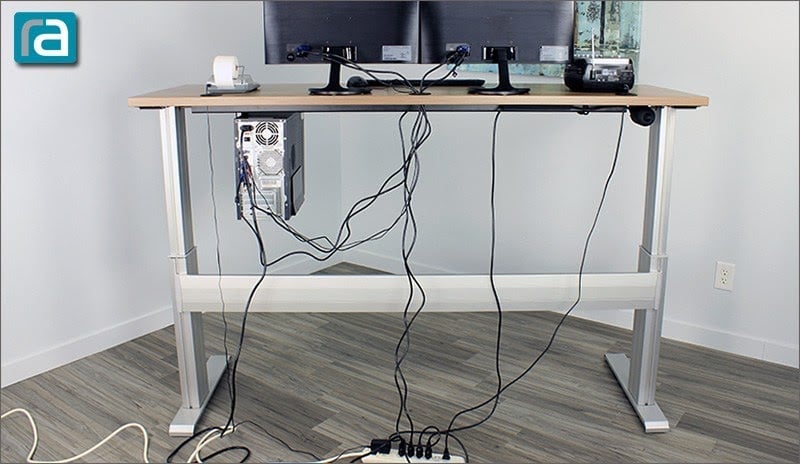
Cables Don’t Last as Long
Not using a cable or wire management system with a sit stand desk reduces the lifespan of a wire by stretching them or exposing them to heat.
Cable manufacturers restrict bending their cables for a reason. If a wire bends too far, damage occurs inside where you can’t see it.
Also, having loose hanging cables opens up possibilities of your foot or drawer getting caught.
The chance of entanglement increases with a standing desk. The occasional tug may not initially cause a problem, but one will arise and eventually require either wire replacement or repair.
Cable Replacement Can Become Difficult
For those with a crazy amount of cords and wires, you may notice that they become entangled. It's now much more difficult to separate an individual wire when it needs to be replaced.
You'll have to sort through all your wires, untangle them, separate the one that needs replacing, and then you can finally remove it and put in the new wire.
Wire Management System Benefits
Wires Live Longer
Proper wire management, planned from the beginning, ensures adequate wire care.
Easier Maintenance
Devices are much easier to maintain with wire management.
Assembling all the wires and cables near the equipment provides easy access. Grouping wires together offer easy identification making maintenance straightforward and easy.
Using a wire management system reduces the risk of disconnecting a wire by mistake.
If you’re reaching for a wire that is inside the tangled mess, you run the risk of grabbing a knot of wires by mistake. When you pull on that mess, it’s possible to disconnect another wire accidentally.
A Cleaner Look
A wire management system also improves the aesthetics of your work area.
A work area where each wire is in place and accessible reflects a well-managed workstation.
Cable Management Solutions
There are many ways to support wires under your adjustable height desk.
In no particular order, here are some of the most popular solutions. These solutions fall into five categories:
- Fasteners
- Cable Sleeve
- J-Channel Raceway
- Under Desk Cable Management Tray
- Wire Management Box
Fasteners
There are various types of fasteners on the market that can help to better management your wires and cables: cable ties, clips, and clamps
Cable Ties
The most basic option for controlling any cables at your sit-to-stand desk are standard cable, wire, or zip ties.
A thin strip of material goes through a hole. That material holds its position due to nested teeth along its length. These teeth allow it to tighten, but not loosen.
Easy to find and cheap, cable ties have many applications and come in four types.
The Five Types of Cable Ties
- Nylon: Nylon cable ties are the classic and most common version. Nylon cable ties come in many colors. They work great if you have many different cables and you need to identify them.
- Reusable: Reusable cable ties have a method to release the teeth from the latching, making them reusable.
- Mounted Head: If you need to bundle a group of wires or cables together, then hang the bundle, use mounted head cable ties.
- Metal: Metal cable ties are more for industrial uses and work best for high heat applications and made of either aluminum or stainless steel.
- VELCRO: Reusable. Hook on one side, loop on the other attaches back to itself for a secure closure.
Any hardware store, shopping center, and most gas stations sell cable ties.
While cable ties do help to declutter, they won't conceal or hide the cables and wires.
Cable Clips & Clamps
In addition to cable ties, there are cable clips and clamps. The two are very similar. They both tend to work better if you're trying to manage only a few cables that tend to be more thin in size.
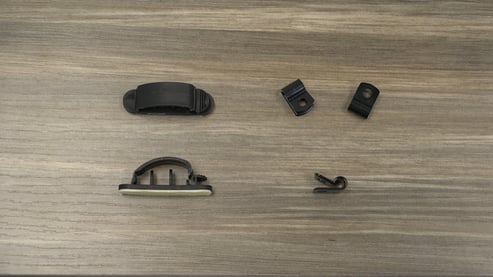
Any smooth surface works with clips, which typically attached using adhesive pads. Attach the clips along the best path and insert the cable. The clip holds the wire firmly in place and removes quickly.
Clamps are an option for combining your cables and routing them out-of-the-way. They are typically a more permanent solution since most are attached to the underside of a worksurface with a screw.
Cable Sleeve
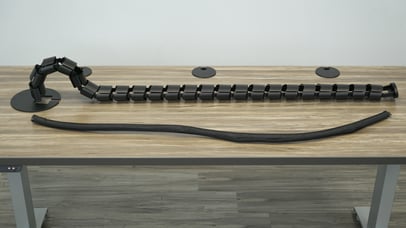
A cable sleeve wraps around the cables and wires protecting them from damage. Sleeves come in many styles and lengths.
When using a cable sleeve, make sure you provide enough length for the wires to move when raising the height of your standing desk. If the sleeve and wires don't have enough slack, they will pull and stretch when going to standing height.
J-Channel Raceway
A J-channel raceway is typically made of a more rigid plastic or metal material, come in a variety of lengths, and attached on the underside of your standing desk.
A majority of raceways are made of plastic and are easily attached to a smooth surface with an adhesive tape.
Under Desk Cable Tray
Cable management trays are generally attached to the underside of a worksurface using screws. They can come in a variety of sizes and styles.
Wires, cables, power strips, and other things are simply placed inside the tray. If you choose this option, you may want to consider using other cable management solutions like cable ties to make it look a bit more neat.
A wire tray like the one shown below will still make all your cords visible. You'll also want to make sure that your cords are somehow secured inside the tray since they may shift when changing the height of your sit stand desk.
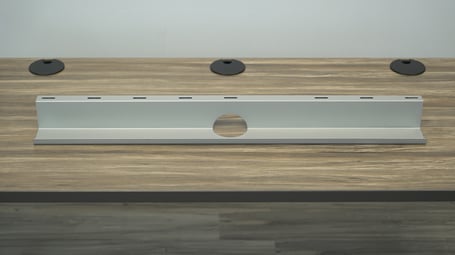
Wire Management Box
A cable management box secures under your desk and collects your cables and cords in a single, tidy place to keeping everything off the floor.
Think of a wire management box as your cable junk drawer - you toss in all your wires, power strips, surge protectors, and then hide it all by closing up the door. You don't have to spend the time neatly securing cable ties or trying to undo other fasteners to replace a wire.
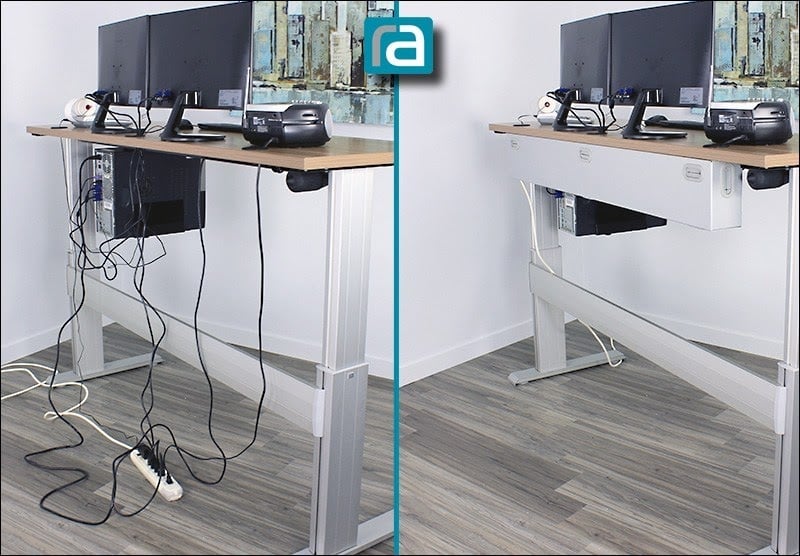
After inserting the front shield, your bowl of cable spaghetti is out of sight and out of mind whether or not your standing desk is at its highest or lowest level.
It makes managing your cables much simpler and faster while still making your workstation look clean and organized.
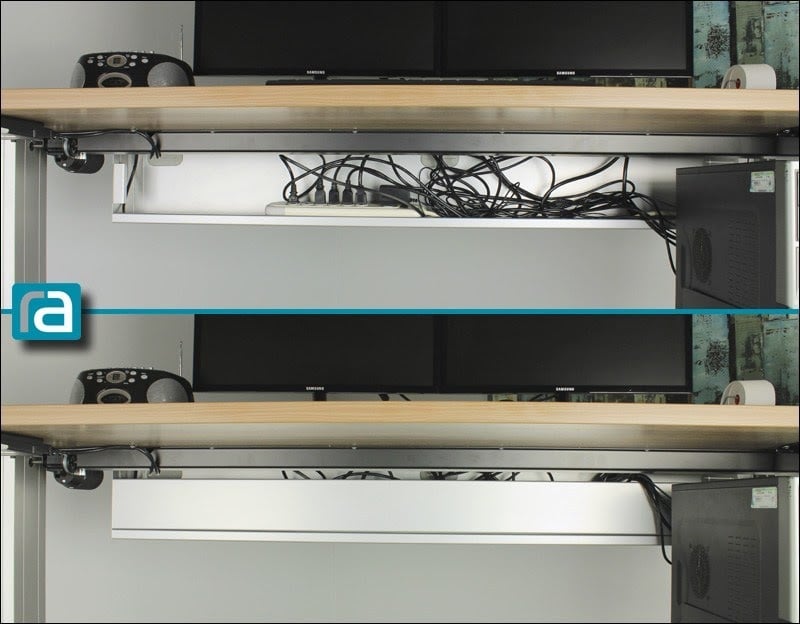

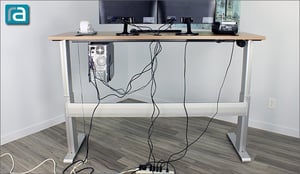
COMMENTS